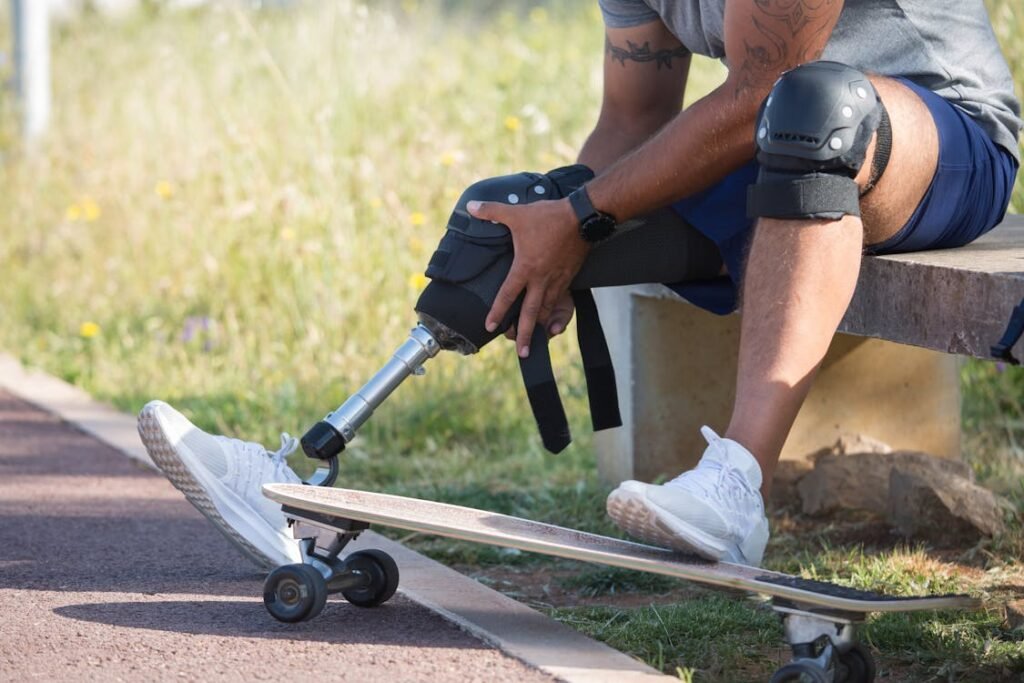For athletes who use prosthetics, performance isn’t just about strength, speed, or endurance. It starts with the foundation—the fit and comfort of the prosthetic itself. A well-fitted prosthetic allows seamless movement, minimizes strain, and enhances confidence, while a poor fit can lead to pain, instability, and even injuries.
Athletes push their bodies to the limit, and a prosthetic must keep up with their demands. Whether it’s a runner sprinting on the track, a cyclist powering through long distances, or a weightlifter maintaining stability under heavy loads, every sport places unique stresses on the body and the prosthetic. This makes precision fit and optimal comfort essential, not just for performance but for long-term health and sustainability in the sport.
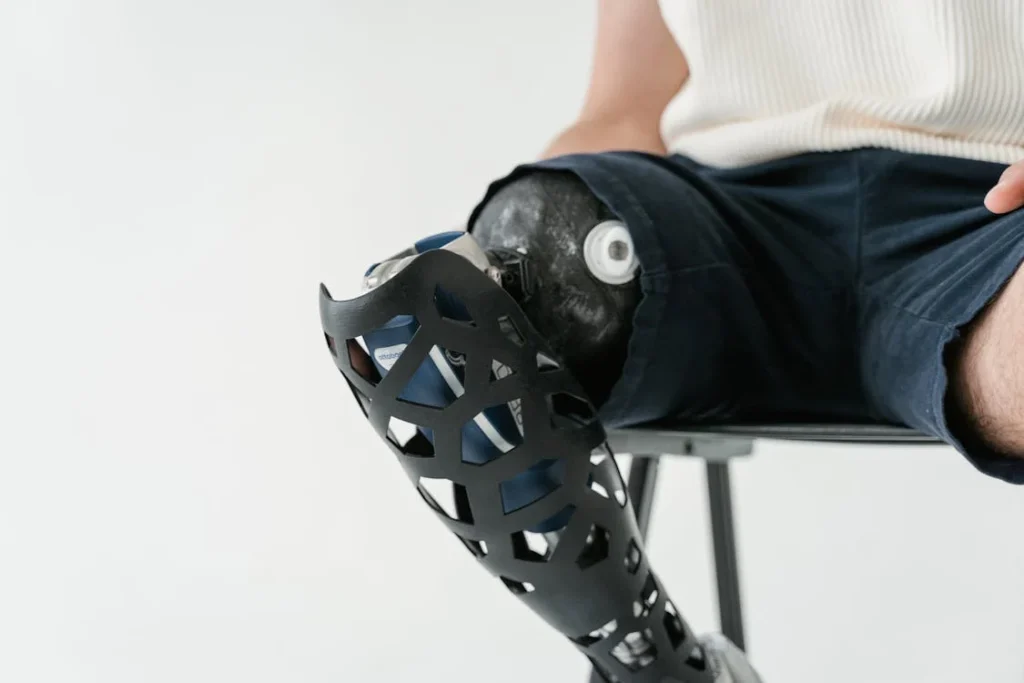
Why Prosthetic Fit Matters in Sports
For an athlete, a prosthetic is more than just a tool—it becomes an extension of their body. Whether running, cycling, jumping, or lifting, the way a prosthetic fits directly impacts movement, balance, and overall performance.
If the fit is incorrect, even the most advanced prosthetic won’t function at its full potential.
A poorly fitted prosthetic can cause serious issues. If it’s too loose, it can slip, reducing control and increasing the risk of injury. If it’s too tight, it can cause discomfort, pain, and circulation problems.
Both scenarios lead to inefficiencies, making movement less fluid and reducing an athlete’s ability to compete at their best.
The key to a great fit is customization. No two residual limbs are the same, and every sport demands different movements. A sprinter needs a secure yet flexible fit that allows explosive power, while a cyclist requires a snug socket that ensures stability without restricting motion.
The socket, suspension system, and alignment must be fine-tuned to match an athlete’s sport, body mechanics, and personal preferences.
The Role of Pressure Distribution
One of the biggest factors in prosthetic fit is how pressure is distributed across the residual limb. Uneven pressure can lead to painful hotspots, blisters, or even long-term tissue damage.
When an athlete moves, the residual limb interacts with the socket, experiencing forces from impact, weight shifts, and repetitive motions. A well-fitted prosthetic distributes these forces evenly, reducing strain and increasing comfort.
For example, a runner’s prosthetic must absorb the shock of repeated foot strikes while maintaining stability. If the pressure is unevenly distributed, it can cause discomfort and force the athlete to adjust their gait, leading to inefficiencies and potential injuries.
This is why many sports prosthetics use advanced socket designs with gel or silicone liners to cushion impact and enhance fit.
Stability and Control in Motion
Athletes rely on their prosthetics to provide stability during high-intensity movements. A prosthetic that shifts unexpectedly or lacks proper alignment can throw off balance, reduce speed, and make precise movements harder to control.
Stability comes from a combination of a secure fit, proper suspension, and alignment with the body’s natural mechanics.
For a long jumper, for example, the moment of takeoff is critical. The prosthetic must remain securely in place while allowing maximum force to be applied. If it shifts or wobbles, it can disrupt the jump and reduce efficiency.
Similarly, in cycling, a prosthetic leg must maintain firm contact with the pedal, ensuring consistent power transfer without unnecessary movement.
A well-fitted prosthetic enhances proprioception—the body’s ability to sense movement and position. When an athlete knows exactly how their prosthetic will respond to motion, they can move more confidently and naturally, improving both performance and safety.
The Psychological Impact of a Secure Fit
Beyond physical benefits, a well-fitted prosthetic provides psychological reassurance. Athletes perform best when they trust their equipment.
If a prosthetic fits comfortably and feels stable, the athlete can focus entirely on their sport instead of worrying about discomfort or mechanical issues.
Confidence plays a massive role in athletic performance. A runner who trusts their blade will push harder without hesitation. A swimmer who feels secure in their prosthetic will dive in without second-guessing.
The right fit doesn’t just enhance movement—it removes mental barriers that can hold an athlete back.
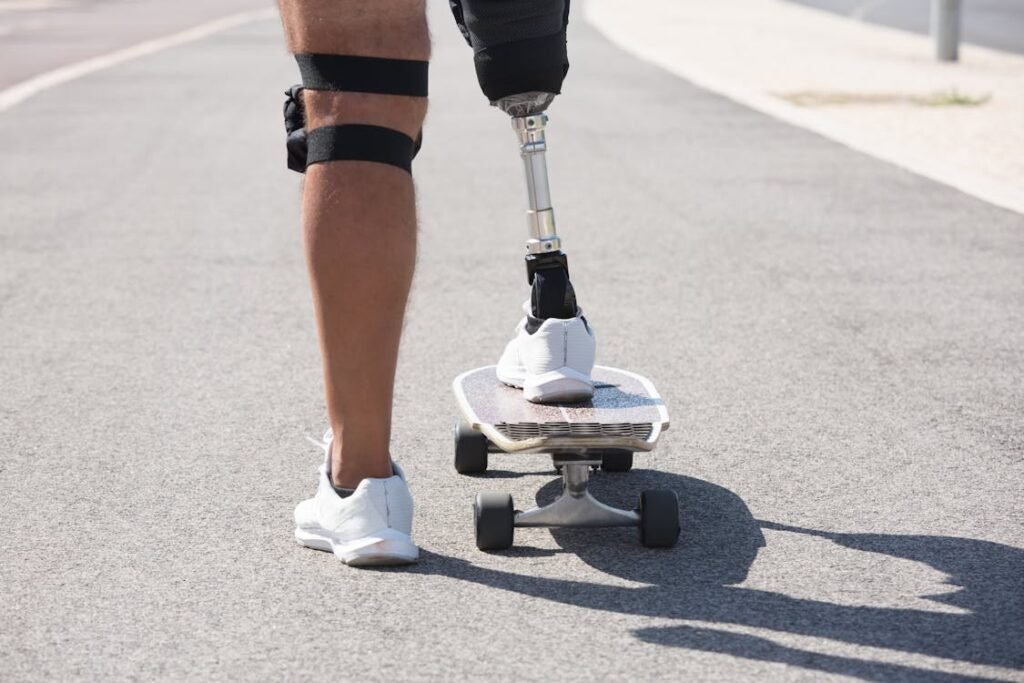
How Comfort Affects Athletic Performance
Comfort is often overlooked when discussing athletic performance, but it plays a crucial role in how well an athlete can train and compete.
A prosthetic that causes irritation, pressure sores, or muscle fatigue can become a distraction, limiting an athlete’s ability to focus on their movements. When comfort is optimized, an athlete can push their limits without being held back by pain or discomfort.
A sports prosthetic should feel like a natural extension of the body. While it may never replicate the exact sensation of a biological limb, it should not cause persistent discomfort.
Achieving this level of comfort involves a combination of proper socket design, suspension system, and material selection.
The Role of Socket Design in Comfort
The socket is the interface between the residual limb and the prosthetic, making it the most critical factor in determining comfort. A well-designed socket should provide firm but gentle contact, avoiding pressure points that can cause pain or skin irritation.
The shape of the socket should match the residual limb’s contours, allowing for a snug yet flexible fit.
Socket liners also play an important role in comfort. Materials like silicone or gel provide cushioning and help distribute pressure more evenly. These liners reduce friction, preventing blisters and skin damage, especially during high-impact activities like running or jumping.
Some advanced prosthetics also use vacuum suspension systems, which create a secure seal that reduces movement inside the socket, leading to better comfort and control.
Managing Heat and Sweat for Maximum Comfort
One of the biggest challenges for athletes using prosthetics is managing heat and sweat buildup inside the socket. Physical activity increases body temperature, causing sweat to accumulate, which can lead to skin irritation and discomfort.
Excess moisture also affects the grip of the prosthetic, making it feel less secure during movement.
Newer prosthetic designs incorporate moisture-wicking liners and breathable materials to address this issue. Some sockets even have built-in ventilation systems to improve airflow and keep the residual limb cool during activity.
Managing sweat is essential for maintaining comfort, especially for endurance athletes who train for long periods.
Reducing Friction and Skin Irritation
Continuous motion in sports can create friction between the residual limb and the prosthetic socket. Over time, this friction can cause abrasions, rashes, or pressure sores, which not only cause discomfort but can also lead to more serious injuries if not managed properly.
Using the right liner and ensuring the socket fits correctly minimizes friction. Some athletes also apply lubricants or barrier creams to sensitive areas to prevent irritation.
Regularly checking the skin for signs of redness or pressure points helps catch potential problems early, preventing them from worsening over time.
Muscle Fatigue and Energy Efficiency
A poorly fitted prosthetic doesn’t just cause discomfort—it forces the athlete to work harder to compensate for inefficiencies in movement.
If the prosthetic isn’t aligned correctly or doesn’t distribute weight properly, the user may have to use extra energy to maintain balance and control. This leads to faster muscle fatigue, reducing endurance and performance.
Energy efficiency is especially crucial in endurance sports like long-distance running or cycling. A prosthetic that works with the body rather than against it allows athletes to move more naturally and conserve energy.
Many high-performance prosthetics incorporate energy-returning materials like carbon fiber, which absorb impact and provide a spring-like effect, reducing strain on the muscles.
The Connection Between Comfort and Confidence
Comfort is not just a physical factor—it directly affects an athlete’s confidence. When an athlete feels comfortable in their prosthetic, they can focus entirely on their sport without distraction.
Discomfort creates hesitation, making movements less fluid and increasing the risk of mistakes.
A well-fitted and comfortable prosthetic gives athletes the freedom to push their limits. Whether it’s sprinting at full speed, performing a high jump, or executing precise movements in a game, comfort allows for full commitment to the sport.
The more natural and pain-free the prosthetic feels, the more the athlete can trust it, leading to improved performance.
At Robobionics, we understand the impact that fit and comfort have on athletic success. Our prosthetic solutions are designed with advanced materials and customized fittings to ensure maximum comfort and efficiency.
If you’re looking for a sports prosthetic that enhances performance, book a free consultation with us today and take the first step toward a better athletic experience.
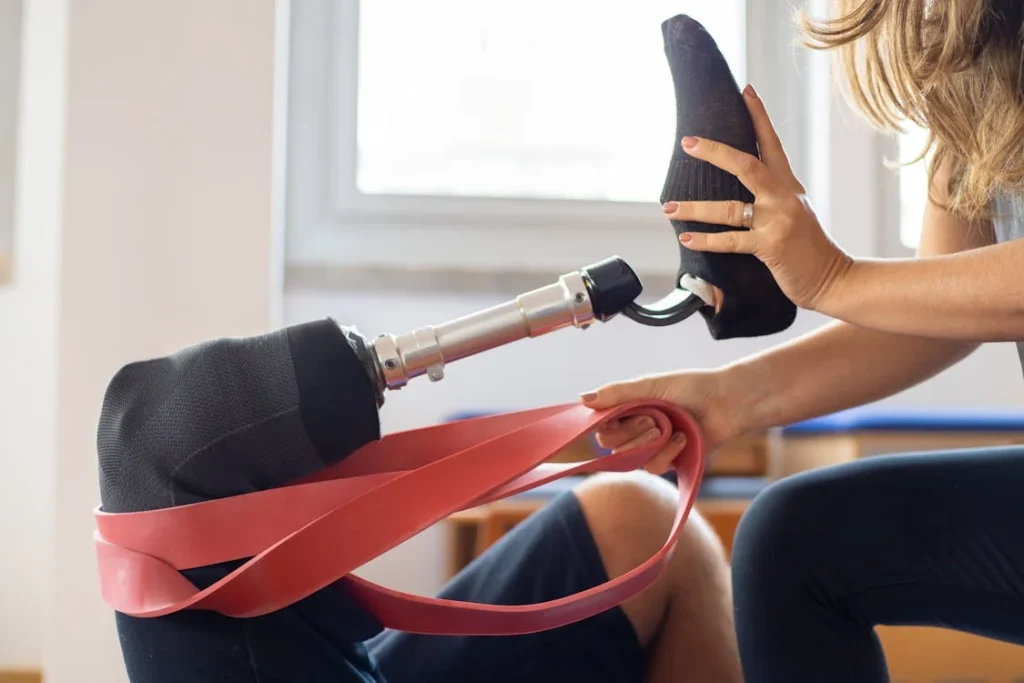
Fine-Tuning the Fit: The Key to Long-Term Success
A prosthetic that feels perfect on the first day might not always feel the same after weeks or months of training.
The human body changes over time, and an athlete’s residual limb can experience shifts in size, shape, or muscle tone due to regular activity. This is why fine-tuning the fit is an ongoing process.
Regular adjustments ensure that the prosthetic continues to meet the athlete’s needs. Even small misalignments can affect performance, causing unnecessary strain on muscles and joints.
Athletes should work closely with their prosthetist to monitor changes and make modifications as needed. Whether it’s tightening the socket, adjusting alignment, or changing the suspension system, these small tweaks can make a significant difference in comfort and efficiency.
The Importance of a Secure Suspension System
A prosthetic’s suspension system determines how securely it stays attached to the residual limb. A loose or unreliable suspension can cause instability, reducing control and making precise movements more difficult.
On the other hand, a system that is too tight can create pressure points, leading to discomfort and restricted circulation.
Different sports require different suspension solutions. A sprinter might need a vacuum suspension system for a snug, responsive fit that prevents movement inside the socket.
A cyclist might prefer a pin-lock system that provides a secure attachment without restricting pedaling motion. Choosing the right suspension method ensures that the prosthetic moves naturally with the athlete’s body, reducing strain and improving performance.
Adapting to Changing Conditions
Athletic environments are not always predictable. Temperature changes, humidity, terrain, and activity intensity can all influence how a prosthetic fits and performs.
High heat, for example, can cause the residual limb to swell slightly, affecting how the socket fits. Wet or muddy conditions might impact grip and traction, requiring additional adjustments for stability.
Athletes should be aware of how their prosthetic responds to different conditions and be prepared to make minor modifications when necessary.
Some adaptive sports professionals carry extra liners, padding, or suspension components to fine-tune their prosthetic based on environmental factors. Learning to make small adjustments on the go can help maintain optimal performance regardless of the situation.
Balancing Flexibility and Stability
One of the most important aspects of prosthetic fit is finding the right balance between flexibility and stability. Too much flexibility can lead to instability, making movements less controlled and increasing the risk of falls or missteps.
Too much rigidity, however, can make movements feel unnatural and limit performance.
For example, in running, a blade that is too stiff may not provide enough energy return, while one that is too flexible might not offer enough support for powerful strides.
Similarly, in weightlifting, a prosthetic that is too rigid might cause discomfort in deep squats, while one that is too loose may not provide the stability needed for heavy lifts.
Fine-tuning the stiffness and flexibility of a prosthetic—whether through adjustments in material composition, alignment, or suspension—helps create a balance that matches the athlete’s needs.
Regular Check-Ups for Long-Term Fit
Even when a prosthetic feels perfect, routine check-ups with a prosthetist are necessary. Over time, wear and tear on components, changes in body composition, or advancements in prosthetic technology may require modifications.
Regular maintenance helps prevent small discomforts from turning into larger problems and ensures that the prosthetic continues to support peak athletic performance.
Robobionics offers expert consultations to help athletes optimize their prosthetic fit for long-term success. If you want to fine-tune your sports prosthetic for better performance and comfort, schedule a session with us today and take control of your athletic journey.

The Science Behind Prosthetic Alignment and Performance
Fit and comfort are not just about how a prosthetic feels—they also impact biomechanics and movement efficiency. Proper prosthetic alignment ensures that an athlete’s posture, balance, and motion remain as natural and energy-efficient as possible.
Even slight misalignments can force the body to compensate in ways that lead to strain, fatigue, and a higher risk of injury.
How Alignment Affects Movement Efficiency
Athletes rely on smooth, controlled movement to maximize performance. A misaligned prosthetic disrupts this flow, forcing other muscles to work harder to maintain stability.
For example, a running prosthetic that is too far forward or backward can throw off stride balance, causing uneven force distribution and increasing joint stress. Over time, this can lead to muscle imbalances, hip pain, or even spinal misalignment.
Cyclists using a prosthetic leg must also pay close attention to alignment. If the limb is positioned at the wrong angle, it can lead to an inefficient pedaling motion, requiring extra effort for each stroke.
A slight misalignment might not be noticeable at first, but over long distances, the added strain can result in fatigue and slower performance.
The Impact of Prosthetic Height on Performance
One often overlooked factor in prosthetic fit is height adjustment. A prosthetic that is even a few millimeters too short or too tall can dramatically alter an athlete’s movement patterns.
If a running blade is too short, the athlete may struggle to generate enough propulsion, reducing speed and efficiency. If it’s too tall, they may have difficulty maintaining balance or experience joint pain due to improper weight distribution.
In strength-based sports, like weightlifting or CrossFit, prosthetic height plays a key role in stability. A lower center of gravity provides better balance, while a height that is slightly off can cause instability during lifts.
Prosthetists work with athletes to fine-tune height settings based on body mechanics and the specific demands of their sport.
Adjusting for Sport-Specific Alignment Needs
Each sport places unique demands on the body, and prosthetic alignment must be tailored to match those needs.
A sprinter, for example, requires a forward-leaning blade that promotes explosive power and speed, while a long-distance runner needs a more balanced alignment to maintain endurance over extended periods.
In adaptive swimming, the alignment of a prosthetic arm or leg determines how effectively the athlete moves through the water. Even slight variations in angle or weight distribution can affect stroke efficiency and drag.
Custom adjustments ensure that the prosthetic enhances, rather than hinders, performance in the water.
Using Technology to Improve Alignment
Advancements in prosthetic technology have made alignment adjustments more precise than ever. Motion analysis software allows prosthetists to track an athlete’s gait, balance, and force distribution in real time.
By analyzing movement data, experts can make micro-adjustments to socket positioning, limb angle, and suspension tightness to optimize fit.
Some modern prosthetics also include smart sensors that detect gait changes and provide real-time feedback. These innovations help athletes and prosthetists fine-tune alignment dynamically, ensuring peak performance in various conditions.
At Robobionics, we integrate cutting-edge alignment techniques to help athletes achieve their best performance. If you’re looking to refine your prosthetic fit and improve movement efficiency, schedule a consultation with our team today.
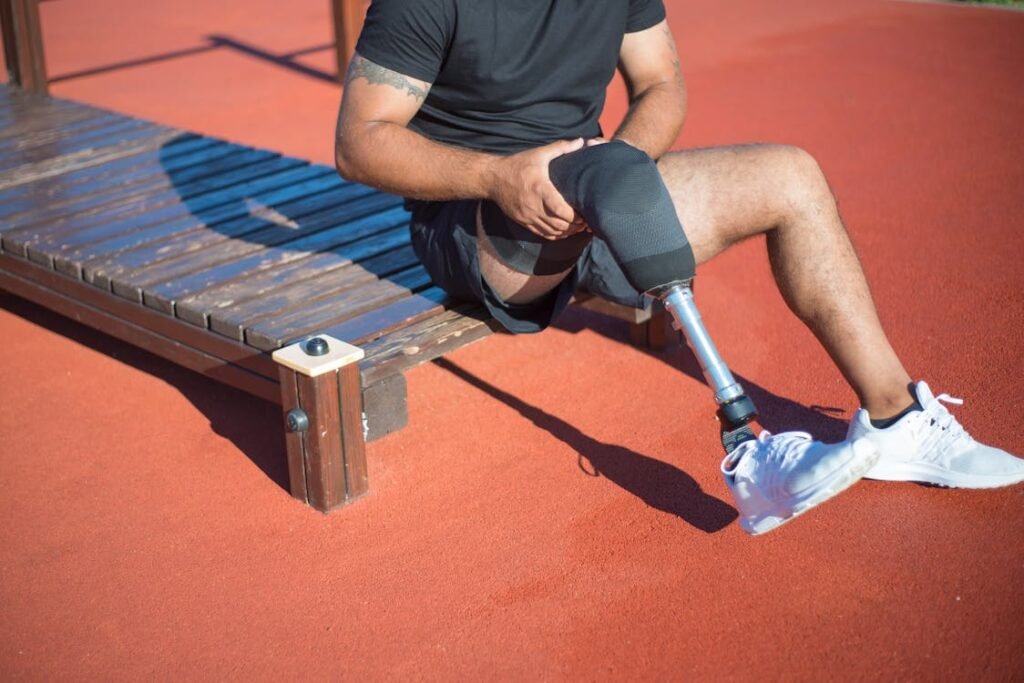
The Role of Material Selection in Fit and Comfort
The materials used in a prosthetic limb play a crucial role in determining its overall fit, comfort, and performance. Athletes put their prosthetics through intense physical demands, so choosing the right materials can mean the difference between optimal movement and discomfort.
Prosthetic components must balance strength, flexibility, and weight to ensure that they perform well without causing strain. A heavier prosthetic can slow down an athlete, while one that is too light might not provide enough stability.
The right combination of materials enhances durability, energy return, and shock absorption, all of which are critical for athletic performance.
Carbon Fiber: The Gold Standard for Sports Prosthetics
Carbon fiber has become the material of choice for high-performance prosthetics. It is lightweight yet incredibly strong, allowing athletes to move efficiently without feeling weighed down.
One of the biggest advantages of carbon fiber is its energy return capability. Unlike traditional materials, which simply absorb impact, carbon fiber stores energy when compressed and releases it when the athlete pushes off.
This is why running blades made from carbon fiber feel springy, allowing for explosive movement.
In addition to its performance benefits, carbon fiber is highly durable. Athletes put their prosthetics under significant stress, from the repeated pounding of a sprinter’s stride to the heavy impact of jumps and landings.
A carbon fiber prosthetic withstands these forces while maintaining its structural integrity over time.
Silicone and Gel Liners: Enhancing Comfort and Fit
While the external frame of a prosthetic must be strong, the interior components that make contact with the residual limb must prioritize comfort.
This is where silicone and gel liners come into play. These materials provide cushioning, reducing friction and pressure on the skin. For athletes who train for extended periods, a soft and adaptable liner can prevent irritation and improve overall endurance.
Gel liners also help with shock absorption, which is particularly beneficial for sports that involve running or jumping. The cushioning effect reduces strain on the residual limb, lowering the risk of overuse injuries.
Some liners also incorporate moisture-wicking technology to manage sweat and prevent skin irritation, a common challenge for athletes who engage in high-intensity training.
Titanium and Aluminum: Balancing Strength and Weight
For structural components, such as pylons and joints, metals like titanium and aluminum offer an ideal mix of strength and lightness.
Titanium is known for its durability and resistance to corrosion, making it a long-lasting choice for athletes who expose their prosthetics to different environments. Aluminum, on the other hand, is slightly lighter, making it a good option for sports that require quick, agile movements.
Choosing the right material depends on the athlete’s sport and personal needs. A powerlifter might prioritize the strength of titanium, while a marathon runner might opt for aluminum to reduce overall weight.
Each material contributes to the prosthetic’s performance in different ways, and a customized approach ensures that athletes get the best combination for their sport.
The Future of Prosthetic Materials
Material innovation continues to advance the field of prosthetics. 3D printing technology is allowing for more customized and cost-effective prosthetic components, giving athletes access to tailored designs that enhance both fit and function.
Researchers are also experimenting with adaptive materials that can change stiffness in response to movement, providing athletes with even more control over their prosthetic performance.
At Robobionics, we use state-of-the-art materials to ensure our prosthetics deliver the best fit, comfort, and durability for athletes. If you’re looking for a high-performance prosthetic that matches your athletic goals, contact us today to explore our cutting-edge solutions.
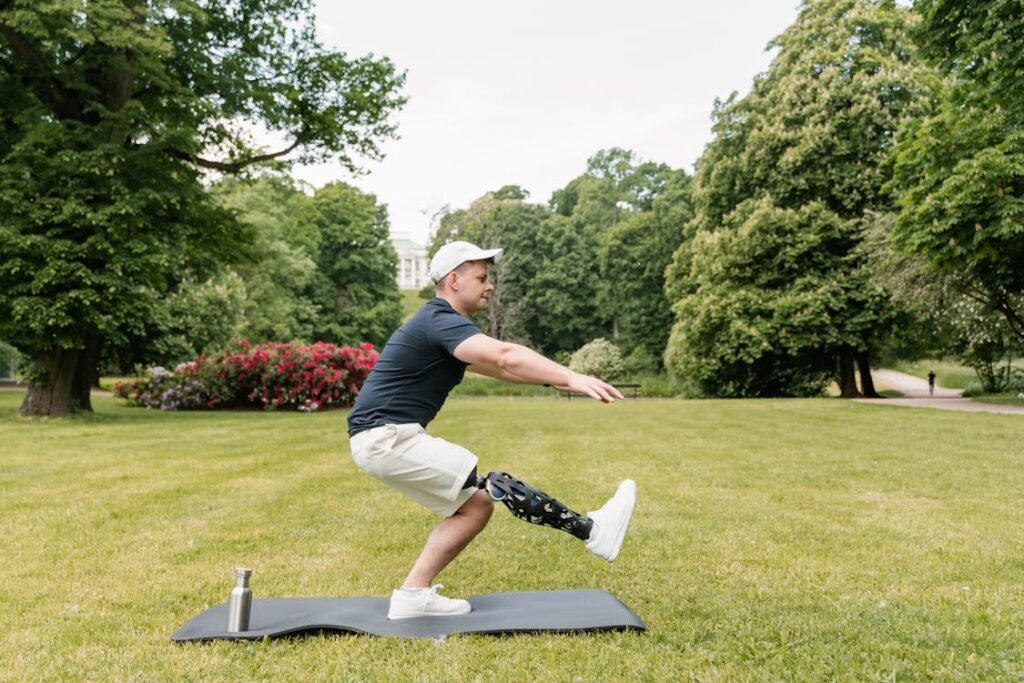
The Impact of Training and Adaptation on Prosthetic Fit and Comfort
Even the most advanced prosthetic won’t perform at its best without proper training and adaptation. Athletes must learn how to work with their prosthetic, fine-tuning their technique and conditioning their body to move efficiently.
The way an athlete trains affects not only their performance but also how well their prosthetic fits over time.
A new prosthetic may feel slightly different at first, even if it has been customized for the user. The residual limb needs time to adjust, and muscles must strengthen to support the new movement patterns.
Without structured training, an athlete may develop compensatory movements that lead to discomfort, imbalance, or even injury.
Strengthening the Residual Limb and Core
Prosthetic comfort isn’t just about the fit of the socket—it’s also about how well the body supports the prosthetic. The residual limb plays a crucial role in stabilizing the prosthetic and maintaining balance.
Strengthening the muscles around the residual limb can improve endurance, reduce strain, and enhance overall comfort.
Core strength is equally important. A strong core helps distribute weight evenly, improving posture and reducing the risk of misalignment. For example, a runner with a weak core may struggle with stability, leading to an inefficient gait.
Incorporating core exercises into training can help athletes move more smoothly and prevent unnecessary pressure on the prosthetic socket.
Learning Proper Movement Mechanics
Each sport requires specific movement patterns, and athletes using prosthetics must ensure they are using the correct mechanics. Improper movements can cause excessive pressure on certain areas of the residual limb, leading to discomfort or skin irritation.
Working with a coach, prosthetist, or rehabilitation specialist can help fine-tune technique and reduce unnecessary strain.
For example, a sprinter using a running blade must learn to engage the hips and drive forward with power, rather than relying solely on the prosthetic to propel them forward.
A cyclist must focus on smooth pedaling motions, ensuring the prosthetic leg moves in sync with the rest of the body. Small adjustments in technique can make a significant difference in comfort and efficiency.
Adapting to Different Training Conditions
Athletes train in various conditions, from outdoor tracks to indoor gyms, and each environment can impact prosthetic fit and comfort. Hot weather can cause the residual limb to swell slightly, affecting how the socket fits.
Cold temperatures may make the prosthetic feel stiffer, requiring adjustments in movement. Understanding how the prosthetic interacts with different conditions allows athletes to prepare and adapt accordingly.
Training in multiple environments also helps athletes build confidence in their prosthetic. Running on different surfaces, practicing balance drills, and simulating game-like conditions ensure that the prosthetic remains comfortable and functional in any situation.
The more adaptable an athlete becomes, the more naturally they will move with their prosthetic.
The Role of Gamified Rehabilitation in Adaptation
One of the most effective ways to accelerate adaptation is through gamified rehabilitation. Interactive training programs use virtual environments, motion tracking, and real-time feedback to help athletes refine their movements in an engaging way.
These programs make the learning process fun while ensuring that athletes develop proper form and technique.
At Robobionics, we incorporate gamified rehabilitation into our training programs, helping athletes transition seamlessly into their sports prosthetics.
If you’re looking for an innovative way to improve your prosthetic fit and performance, contact us today to learn more about our adaptive training solutions.
Conclusion
A well-fitted and comfortable prosthetic is the foundation of athletic success. It allows athletes to move efficiently, reduce strain, and focus entirely on their performance without distractions. When fit and comfort are optimized, an athlete can train harder, compete with confidence, and push their limits without the fear of discomfort or injury.
From precise socket design to advanced materials and personalized adjustments, every detail plays a role in ensuring that a prosthetic enhances—not hinders—performance. Ongoing training, proper alignment, and adaptation to different conditions further refine the athlete’s experience, making the prosthetic feel like a natural extension of their body.
At Robobionics, we are dedicated to helping athletes achieve their full potential with cutting-edge prosthetic solutions. Whether you’re looking for a new sports prosthetic, need expert adjustments, or want to explore gamified rehabilitation, we’re here to support your journey.
If you’re ready to take your athletic performance to the next level, book a consultation with our experts today. The right fit changes everything—start your journey to peak performance with Robobionics.



